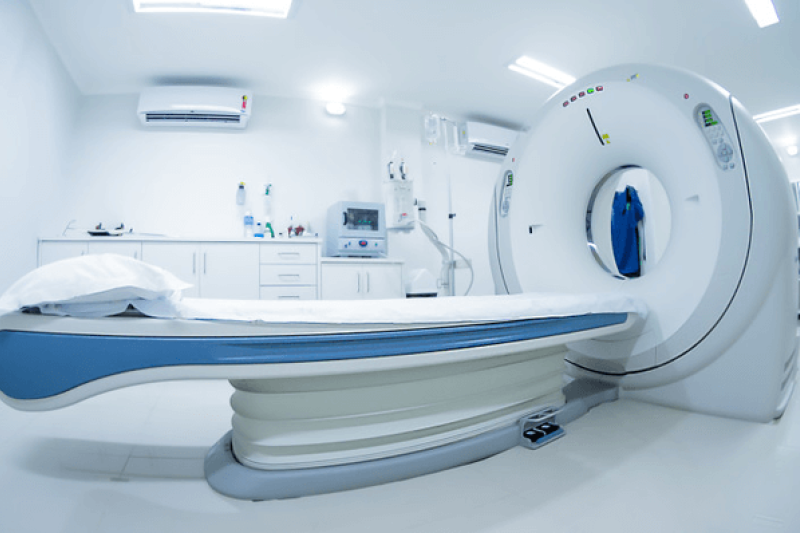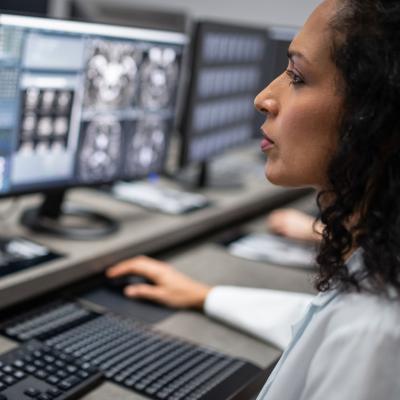- AdventHealth University

A career as a computed tomography (CT) technologist offers a wide range of opportunities and benefits. Every day, CT technologists use specialized equipment to take images of patients’ bodies, generating scans that assist in diagnosing diseases and identifying internal injuries. These crucial medical professionals collaborate with doctors and nurses, give patients peace of mind, and deliver the best possible care.
Those with a passion for making a difference and identifying life-saving diagnoses should consider a career as a CT technologist. The first step to a fulfilling and rewarding job in the CT industry is the right education, and a Bachelor of Science in Imaging Sciences Online will help move your career to the next level.
Duties of a CT Technologist
The primary duty of a CT technologist is to perform CT scans. The scans use a combination of X-ray machines and computers to create cross-sectional and 3D images of the body. The images provide more detailed information than normal X-rays, with the ability to show blood vessels, soft tissues, and bones in various parts of the body.
On any given day, CT technologists may perform dozens of CT scans in various settings such as medical facilities, clinical settings, or hospitals. The role requires outstanding patient care and working with cutting-edge machinery, making it an attractive position for those with excellent interpersonal skills and a deep interest in technology.
Before a scan, CT technologists will:
- Review clinical information of incoming patients and assess documentation to ensure a safe, accurate scan
- Determine the positioning of the body for optimal imaging, accounting for patient mobility and comfort
- Explain the examination process to the patient and answer any questions
- Apply radiation protection principles to minimize unnecessary exposure
CT technologists may also be responsible for administering an intravenous contrast agent to highlight the area in question, if requested by the doctor. For thoracic diagnostics, they may administer iodinated contrast to show possible obstructions in the heart and great vessels. For scans of the digestive system, they may administer oral contrast media to enhance the anatomy of the digestive tract.
During the scan, the CT technologist will be in a separate room from the patient and communicate via intercom. The CT technologist will then facilitate the imaging process using the scanner, ensuring images are clear and high quality for the radiologist’s review.
Following the scan, the CT technologist will answer any follow-up questions the patient may have, help the patient off the scanner, and transfer them to another department of the medical facility or escort them from the imaging facility. In some cases, the radiologist may consult with the CT technologist on the interpretations of the images.
While performing CT scans is their primary responsibility, CT technologists also:
- Perform daily tube warm-ups and calibrations to ensure equipment is clean, safe, and functioning correctly
- Follow strict sterilization procedures and practice aseptic cleaning techniques to prevent bacterial contamination
- Cooperate with internal and third-party quality assurance teams to evaluate different techniques and improve overall quality
How Much Does a Computed Tomography Technologist Make?
A CT tech salary is competitive and the job offers individuals the prospect of employment security in the coming years. According to PayScale, the median annual CT tech salary in the U.S. is about $64,000 as of June 2021 — with the average pay range between $47,000 and $91,000, depending on location and experience level.
Additionally, the U.S Bureau of Labor Statistics estimates that demand for radiologic technologists, which includes CT technologists, is expected to increase by 7% by 2029 — faster than the projected average job growth rate of 4%.
A CT tech salary is highly dependent on key factors, such as certifications, education, additional skills, and experience.
How to Become a CT Technologist
The first step to becoming a CT technologist for most individuals will be an associate degree from an accredited program in a relevant area of study such as:
- Radiography
- Radiologic technology
- Radiologic sciences
- Nuclear medicine technology
- Diagnostic medical sonography
To increase job opportunities, pay range, and employability, many CT technologists will pursue a bachelor’s degree in radiologic technology, such as a Bachelor of Science in Imaging Sciences Online. After graduating from an accredited program and completing specific education in computed tomography, individuals must then sit for and pass their CT Registry Exam, administered by the American Registry of Radiologic Technologists (ARRT), to be able to work as a CT technologist.
More than 75% of states have licensing laws that cover the practice of radiologic technology. In those states, a license must be obtained before one can practice as a CT technologist. States do differ, but most accept certification from:
- American Registry of Radiologic Technologists (ARRT)
- Nuclear Medicine Technology Certification Board (NMTCB)
Learn More About Becoming a CT Tech
AdventHealth University has been a leader in providing outstanding healthcare degrees since 1992. Today, the university offers vanguard education and dedicated faculty members who are committed to assisting students in the pursuit of exciting medical career paths, including CT technologists.
A CT tech salary is attractive, and the role offers job security and the opportunity for a highly fulfilling career in the healthcare industry. Learn more about what a CT tech is and how you can achieve your career goals with the Bachelor of Science in Imaging Sciences Online at AdventHealth University.
Recommended Readings
Types of Medical Imaging: Technologies and Career Options
Radiologic Technologist vs. Ultrasound Technologist: Roles and Responsibilities
Health Imaging for Women: Medical Applications, Benefits, and Careers
Sources:
American Registry of Radiologic Technologists, Computer Tomography
PayScale, Average Computed Tomography (CT) Technologist Hourly Pay
U.S. Bureau of Labor Statistics, Radiologic and MRI Technologists


